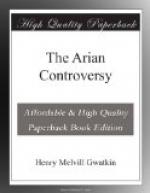of the Holy Spirit is shown by many convergent lines
of evidence, but it was still an open question whether
that divinity amounts to co-essential and co-equal
deity. Thus Origen leans to some theory of subordination,
while Hilary limits himself with the utmost caution
to the words of Scripture. If neither of them
lays down in so many words that the Holy Spirit is
God, much less does either of them class him with the
creatures, like Eunomius. The difficulty was the
same as with the person of the Lord, that while the
Scriptural data clearly pointed to his deity, its
admission involved the dilemma of either Sabellian
confusion or polytheistic separation. Now, however,
it was beginning to be seen that the theory of hypostatic
distinctions must either be extended to the Holy Spirit
or entirely abandoned. Athanasius took one course,
the Anomoeans the other, but the Semiarians endeavoured
to draw a distinction between the Lord’s deity
and that of the Holy Spirit. In truth, the two
are logically connected. Athanasius pointed this
out in the letters of his exile to Serapion, and the
council of Alexandria condemned ’those who say
that the Holy Spirit is a creature and distinct from
the essence of the Son.’ But logical connection
is one thing, formal enforcement another. Athanasius
and Basil to the last refused to make it a condition
of communion. If any one saw the error of his
Arian ways, it was enough for him to confess the Nicene
creed. Thus the question remained open for the
present.
[Sidenote: Council of Lampsacus (364).]
Thus the Semiarians were free to do what they could
against the Homoeans. Under the guidance of Eleusius
of Cyzicus, they held a council at Lampsacus in the
summer of 364. It sat two months, and reversed
the acts of the Homoeans at Constantinople four years
before. Eudoxius was deposed (in name) and the
Semiarian exiles restored to their sees. With
regard to doctrine, they adopted the formula like
according to essence, on the ground that while
likeness was needed to exclude a Sabellian (they mean
Nicene) confusion, its express extension to essence
was needed against the Arians. Nor did they forget
to re-issue the Lucianic creed for the acceptance
of the churches. They also discussed without
result the deity of the Holy Spirit. Eustathius
of Sebastia for one was not prepared to commit himself
either way. The decisions were then laid before
Valens.
[Sidenote: The Homoean policy of Valens.]
But Valens was already falling into bad hands.
Now that Julian was dead, the courtiers were fast
recovering their influence, and Eudoxius had already
secured the Emperor’s support. The deputies
of Lampsacus were ordered to hold communion with the
bishop of Constantinople, and exiled on their refusal.




